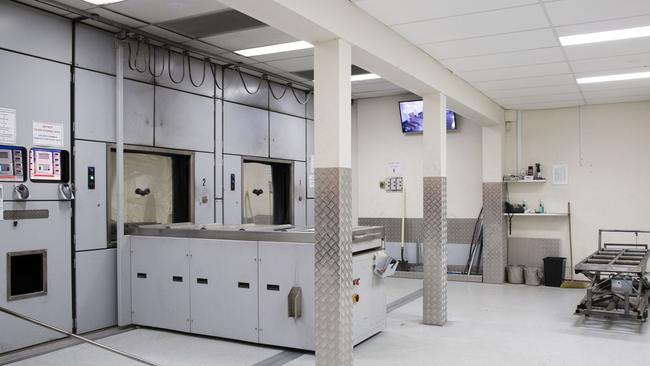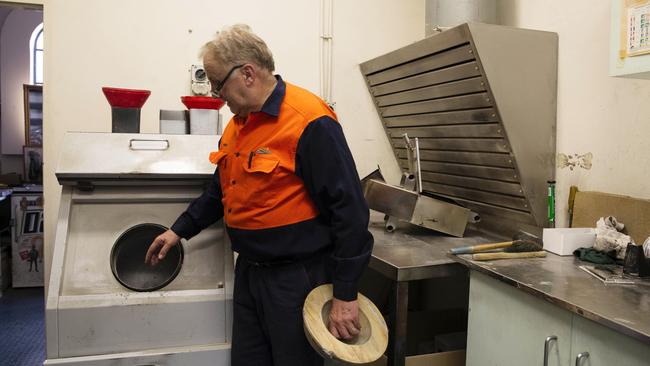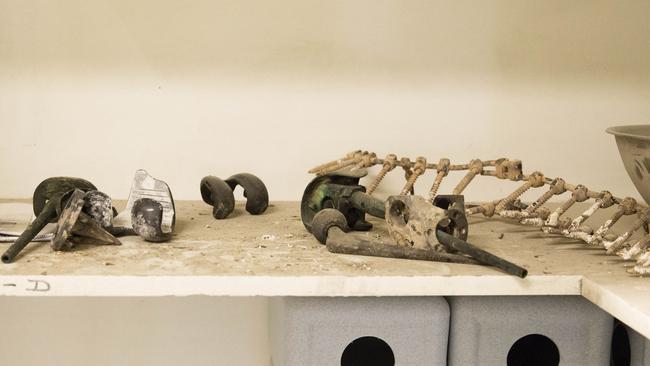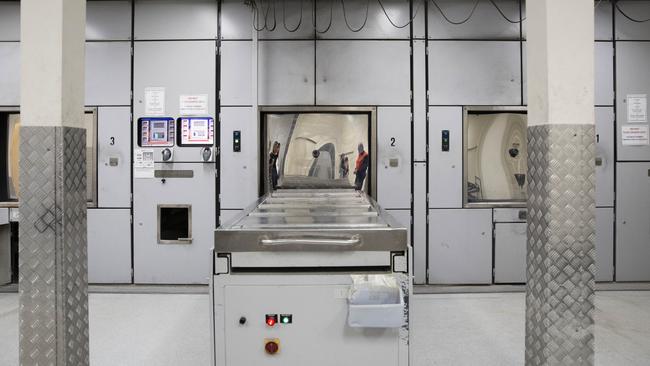Death industry: inside one of Australia’s biggest crematoriums
WHAT goes on behind the scenes of a crematorium? From measuring fires to replacement body parts that survive the heat — it’s never dull.
WARNING: Graphic content
THERE’S no escaping death.
Or as the great Benjamin Franklin once said: “In this world nothing can be said to be certain, except death and taxes.”
An average of 159,000 people die in Australia each year, according to the Australian Bureau of Statistics.
About 70 per cent of those in urban areas opt for cremation. The figure is about 56 per cent in non-urban areas.
The cremation process is one usually hidden from the general public. The sheer thought of it is something most people would prefer disappeared into a black hole.
But for many who work in the death industry it’s something they stare in the face multiple times a day.
Crematorium operator David Bennett has been working at the NSW Northern Suburbs Memorial Gardens and Crematorium, the second oldest in Australia, for three years. He arrives on the job in the Sydney suburb of Ryde every weekday at 6am.
“We’ve done 357,000 plus cremations since it opened in 1933,” Mr Bennett told news.com.au.
Mondays are typically “fairly quiet” at the crematorium. The facility usually receives about 10 bodies in sealed coffins from funeral directors on those days.
“Friday can be up to 30 plus, it gets quite busy,” Mr Bennett said.
“The families tend to do it at the end of the week rather than first thing on Monday.
“We try to do them in the order they come in and fulfil any special requests from family or funeral directors.
“It’s not a good time for anybody so the more we can do for the family and make them feel good, the better.”
Once a body has been delivered in a coffin to the crematorium it’s given a metal name plate with a unique number “for traceability”.
“We remove the name plates from the casket and they go with the ashes all the way through to give it to the family so there is no mixing them up,” Mr Bennett said.
Mr Bennett said every corpse sent to the facility for cremation is listed on a run sheet to “make sure we’ve got the right person”. Staff also checks and signs off on paperwork before each one is inserted into the furnace. The crematorium is also monitored by surveillance cameras.
“Somebody is watching us at all times. That way we can’t make a mistake,” Mr Bennett said.
“I’ve got to make sure there are no pacemakers, and no other objects that can create a problem for us.
“Pacemakers are bad because they have been known to explode in the cremator and it can cause a lot of damage and at $110,000 to repair it’s an expensive proposition.”

The crematorium features three steel cremators side-by-side. Each one is operated by a handheld control and fitted with a computer screen to monitor temperatures, smoke, gas and suction. According to Mr Bennett, “the computer does everything” and can also be accessed and operated remotely by the cremator manufacturers in Melbourne.
The main temperature in the furnace needs to be between 800 — 1000 degrees Celsius before the chamber door can be opened and a coffin inserted. The door opening is 949mm high and 1158mm wide. It’s the biggest in Australia so “if you can’t fit in there, you can’t be cremated”.
“As soon as the temperature is up we can start putting the bodies in,” Mr Bennett said.
A tray on a conveyor belt moves the coffins into the chamber. The dead always go in feet first.
“We charge the casket in and it will start to catch fire straight away,” Mr Bennett said.
“A large jet comes down from the top and will burn the lid off first.
“There’s a banana shape on the bed so when the casket goes in there’s a gap underneath and the air gets underneath it and burns a lot quicker.
“So you get rid of the box straight away and then the body starts to burn and that’s what we’re after.”

A “standard size body” takes about an hour and a half to be cremated. A large corpse can take up to four and a half hours. Mr Bennett said some morbidly obese bodies had been known to start fires and therefore had to be carefully monitored during cremation.
Mr Bennett said risky and lengthy cremations were monitored remotely by the cremator manufacturers in Melbourne.
“We set it up in the afternoon and I can go home and have a nice cup of tea,” he said.
“They will up and down the suction to keep the temperature roughly about 1000 degrees while it’s burning. If it starts to get too hot, they’ll put more suction on, which drops the temperature.
“You’ve got water in there which helps keep the temperature balanced as well.”
The remains, mostly calcified bones, eventually fall down a narrow funnel and into a pit at the bottom of the cremator.
They are then raked into a removable “ash box”.
“I wear protective clothing — a face mask and gloves — so I don’t burn,” Mr Bennett said.
“Families want to know 100 per cent that what they’re getting is their loved ones and we guarantee that.”
The ashes, along with the corresponding name plate, are then taken to the “prep room” where they are placed on an “instruction fan” that cools them down. An “action processor” then grinds the calcified bones into dust.
“The name plate follows it and then it all goes into a PVC box,” Mr Bennett said.

An average container of human ashes weighs between four and six kilograms, depending on the person’s body size at the time of cremation.
The containers are labelled with the person’s unique number on the front, back and inside.
“We have had a case where the police turned up with a box and it had a Northern Suburbs label … because of the unique number we could trace the family and return the ashes to them,” Mr Bennett said.
Hundreds of containers full of ashes line the shelves of a secure storage room inside the facility. Some will be collected by family members later that day or in the near future. Others have been sitting there for up to 20 years.
“We’ve got to keep them locked for security reasons,” Mr Bennett said.
“As you can see we’ve got quite a few ashes that are yet to be collected.
“We had some that are 20 plus years old that have been left in the system.
“They’re still here and we’re sending out letters to the families.”


The crematorium doesn’t dispose of anyone’s ashes until a family member signs for it.
“It should be only 18 months we hold them for but because we’re family oriented people we keep trying to get the families involved so they can either have a memorial or take the ashes,” he said.
To the corner of the prep room is a large, black bucket full of metal and ceramic knee caps, femurs, elbows and other replacement body parts that don’t melt in the cremators.
“There’s a lot of metal that comes out of it that we collect,” Mr Bennett said.
“There’s all sorts of stuff that we pull out: We have ceramic knees, old school knees, femurs, I think I’ve got an elbow in here somewhere.
“Unfortunately you can’t re-use them because I’d get my knees done cheap then.
“Here’s a spine with screws through it, someone had a very bad back.
“A lot of (teeth fillings) just disappear.”


The metals pulled from the cremators are later sold to a recycler. The money is donated to different charities, including Police Legacy and the Lions Club.
Mr Bennett said replacement body parts made from titanium have to be shipped to the Netherlands because there isn’t a furnace strong enough to melt them in Australia.
To the left of the three cremators is a viewing room where families can watch their loved ones be inserted into the chamber. Only a glass window separates them. Mr Bennett said a lot of Hindus “lie on the floor and pray” as their loved ones are cremated.
“Under occupation health and safety rules we’re not allowed to leave family in the cremator room because many years ago they had a lady here whose husband was going in and she tried to jump in,” Mr Bennett said.
“They had to tackle her and drag her out. It can be daunting sometimes. We’ve had the smashing of glass by a woman upset that her daughter was being cremated.
“There are times when you’re OK and don’t think about it.
“Then there are other times where you get quite emotional.”
Mr Bennett said there were many common myths surrounding cremation.
“You’d be surprised how many people think we take the body out of the coffin and re-use the coffin,” he said.
“We never put a body into the chamber on its own. It’s always in a coffin.”

Children are often cremated with their favourite toys or soccer balls but not just anything can go in.
“Unfortunately we can’t burn all the flowers the little, green plastic they stick all the flowers into, really ruins the cremator,” Mr Bennett said.
“We put as many flowers as we can on, along with all the money the Chinese often put on top of (their loved ones’) coffins, and dispose of the rest.
“If I take flowers home to my wife I have to show a receipt.”
Northern Suburbs Memorial Gardens and Crematorium operations manager Ana Kingi told news.com.au that clients make cultural requests “all the time”.
“In the Korean culture, they burn material, as a representation,” she said.
“So some people bring in a bag of material once a month to be cremated in remembrance of their beloved and we do it.
“And there was somebody recently who had these Viking beliefs and so they wanted to be buried with their sword and their little axe.
“The family afterwards (requested) the residue of the metal.”
Ms Kingi said the trend to cremate instead of bury was on the rise because it’s a more cost effective and energy and space efficient option for families.
She said the facility’s cremation fees start from about $1500, with memorial, service and funeral director fees on top of that.
“We found that a lot of people ask those same questions about traceability and about respectful handling,” Ms Kingi said.
“For them to see how respectful the processes we have in place are and that we make sure the identity and integrity is maintained every step of the way, it reassures them.”
Ms Kingi said it was the different ways people “found closure” that has struck her most during her years running the crematorium.
“Some families and cultures keep it very small and intimate and others have a big fanfare,” she said.
“It’s never dull.”




